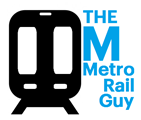Mumbai Metro’s Line-3 Inaugurated; Ops to Begin on October 7
I’ve kept tabs on Mumbai’s Line-3 since its inception, right through contract finalization, tunneling works, and can’t believe a part of it is now days away from opening!
India’s Prime Minister Narendra Modi today inaugurated Phase 1 of Mumbai Metro’s 33.5 km Line-3 (Aqua Line) from an event held at Bandra-Kurla Complex Station (BKC). In addition, he also laid the foundation for 29 km Thane Metro project.
12.69 km Phase 1 of Mumbai’s Line-3 connects Aarey JVLR – Bandra Kurla Complex and includes 9 underground & 1 at-grade station. Mumbai Metro Rail Corporation (MMRC) had started basic trial runs (train testing) here using one of their Alstom 8-coach Metropolis trains in August 2022, and proper integrated testing finally started in March 2024.
The project’s construction is financed by Japan International Cooperation Agency (JICA) with its execution being overseen by General Consultants MAPLE, a consortium comprising of AECOM, PADECO, Louis Berger and Egis Rail.
Mumbai’s Aqua Line will be operated by Delhi Metro Rail Corporation (DMRC) for a period of 10 years. DMRC will initially operate 9 trains with 96 roundtrips daily at a headway of 6 minutes and 40 seconds during peak hours. Fare (ticket prices) will range from Rs. 10 – 50.
Per MMRC, commercial operations (passenger services) will start at 11 am on October 7 (Monday) with the last train departing at 10:30 am. Full fledged operations will begin on October 8 (Tuesday) with trains running between 6:30 am and 10:30 pm (Monday to Saturday) and 8:30 am and 10:30 pm (Sunday).


Video:
The underground tunnels and stations of Aqua Line’s Phase 1 were built via 3 civil packages awarded in July 2016. From north to south:
- 4.15 km Package UGC-07 (Larsen & Toubro – SUCG JV): Sariput Ramp – CSIA T2; Final breakthrough recorded by TBM D213 (Wainganga-2) in December 2019.
- 4.45 km Package UGC-06: (J Kumar Infraprojects – CRTG JV): CSIA T2 – Santa Cruz MVS ; Final breakthrough recorded by T62 (Tapi 2) in February 2021.
- 4.94 km Package UGC-05 (J Kumar Infraprojects – CRTG JV): Santa Cruz MVS – Dharavi ; Final breakthrough recorded by TBM S64 (Godavari-4) in August 2020
Besides supplying trains, Alstom Transport has also installed the line’s 25 kV overhead electrification (OHE) system. A complete list of Line-3’s contractors can be viewed here.

Here’s a video shot 2 weeks ago with visuals from inside the train and stations:
Line-3’s future was uncertain for a period between 2019-2022 over Aarey Depot & its Operational Control Centre’s location at Aarey Milk Colony which I wrote about extensively here. During that period, MMRC’s Managing Director was replaced by a no-name figure in January 2020 and brought back in July 2022, resulting in low employee morale for a period of 30 months.
While the depot issue affected the start of integrated trial runs, an unusual long time was taken MMRC & its contractors to complete station finishing and system installation works since Phase 1’s final breakthrough in 2020.
After the final tunnel breakthrough, operators elsewhere in India have taken no more than 2 years to operationalize their lines. In fact in Agra, its Priority Corridor was operationalized just 3 months after the final breakthrough was recorded in December 2023.
I guess I could cut some slack as this is undoubtably the most complex and challenging mass transit line in the country. It includes a cool 227m “scissor” crossover cavern at Sahar Road made by dismantling tunnel rings, and the station at Sahar Road itself has historic water pipelines, some as old as 50 years, running right through it.
Here a few images by Prashant Joshi of BKC Station, decked up for the inauguration, which includes a small underground train stabling facility:


I see Line-3’s Phase 2 (BKC – Acharya Atre Chowk in Worli) with 6 underground stations on packages UGC-04 and UGC-03 opening up no more than 4 months from now. Fun fact – the 1st of 17 tunnel boring machines (TBMs) of the entire line was commissioned on UGC-04 between Nayanagar Shaft & Dadar in November 2017.
Coming back to Phase 1, when Line-3 goes live Mumbai Metro’s network will become 59.19 km long making it India’s 4th largest metro system behind Delhi Metro (351.2 km), Bangalore Metro (72.2 km) and Hyderabad Metro (67 km). On its way to this figure, it will surpass Chennai Metro (54.1 km), Ahmedabad Metro (58.66 km) and Kolkata Metro (58.68 km) – see my quick snapshot of all metro systems over here.
As I raise my glass in toast to all those involved in Line-3’s execution, I can’t help but be disappointed by how ticketing will be separate across all lines due to ownership, how the tendering process for critical system contracts of all other lines continues to get dragged out, and how roughly only 10% of the network is planned underground in a heavily built-up and land-starved city like Mumbai. It’s almost 2025. The city deserves better than how Mumbai Metropolitan Region Development Authority is handling its mass transit.
For more updates, check out the Mumbai section or my Home Page! Sign up for free instant email notifications on new posts over here. Like this post? Get early-access to updates and support the site over here.
– TMRG




Congratulations to entire team of J Kumar 💐 Proud to be part of the project
Good coverage. Why do you not like MMRDA’s transport plans?
For the above reasons and for choosing random other platforms – monorail (poor winding route and not needed prior to building out a metro network) and Pod Taxi (limited capacity, unproven tech for large districts, and will consume sidewalk / open spaces in one of the few planned districts outside of SoBo)
We won! Best wishes to Ashwini Bhide
This inauguration feels so different from any other. There are so many emotions of so many people herw, I am really really happy today.even though I am not from Mumbai, but I felt the pain in November 2019 just like many mumbaukars did and today this feels so personal.
Isn’t frequency too low?
They’ll adjust based on demand and availability of trains to service
Was trying to find out if the airport stations are integrated into the terminals in some way but can’t figure that out yet. Any ideas/pictures of it?
Both stations are open albeit in a limited capacity due to pending work.
At T2, there’s an underground walkway connecting the station box to T2’s multi-level car parking lot which is connected to the actual terminal.
At T1, station box is located across the road from Taj Santacruz. I don’t believe there’s a dedicated connection like at T2.
Few pics: https://x.com/RajputAmar/status/1842395513980907609
that was and is the burning question in many peopl’s mind . Especially for T2 as the same site will also hold stations/platforms for Line 7A and line 8.
Congratulations to current Maharashtra Government,it’s official specially metro lady of Maharashtra Ashwini bhide ji and l&T team.
True intentions and fast execution is wheel for fast development
While I am excited about Line 3 opening after so many setbacks, i am disappointed with the response it has got (in terms of ridership) in the initial days. I am sure it will pick up. But some issues seems like hampering it. 1- Connectivity of stations, 2- No dedicated connection to inside of terminals, 3- No direct connection with Marol Naka metro station also. Read some where commuters need 6-8 mins to change line 1 to Line 3 at Marol Naka. Why do they come up with such plans ?? Easy accessibility, easy transfer between different transport modalities is always found lacking in India.